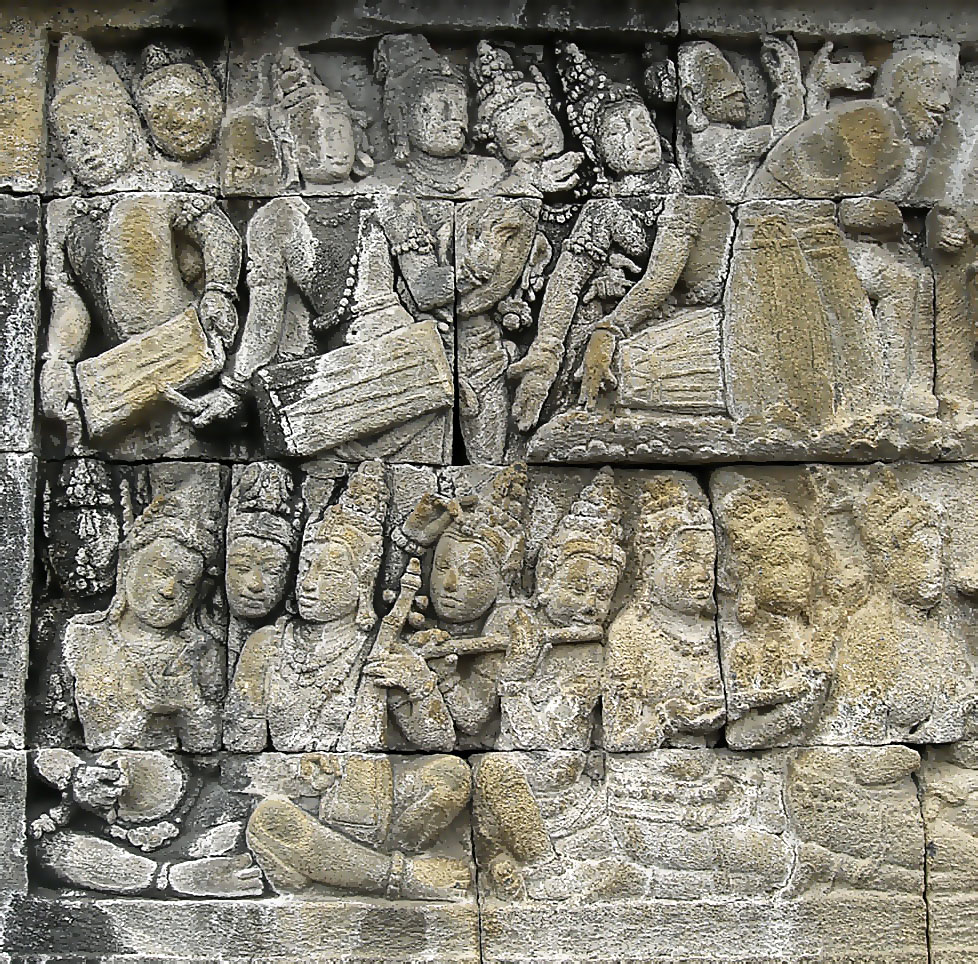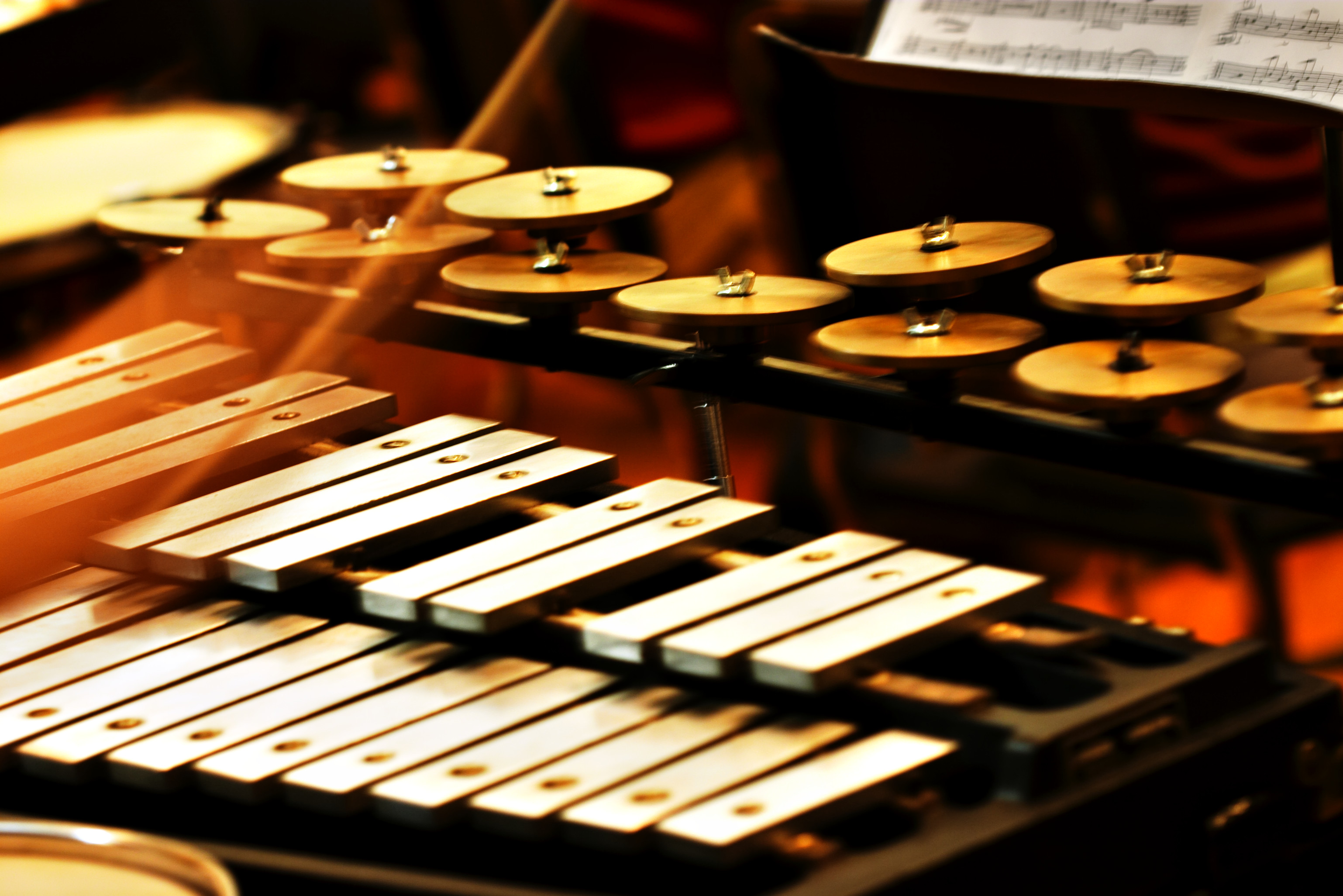|
Gangsa
A gangsa is a type of metallophone which is used mainly in Balinese and Javanese Gamelan music in Indonesia. In Balinese gong kebyar styles, there are two types of gangsa typically used: the smaller, higher pitched and the larger . Each instrument consists of several tuned metal bars (either iron or bronze) each placed over an individual resonator. The bars are hit with a wooden , each producing a different pitch. Duration of sound intensity and sound quality factors are generally accomplished by damping the vibration of the bar with the fingers of the free hand. Balinese gong , as with other metallophones in gong ensembles, are played in neighboring pairs with interlocking, rapid-tempo parts that elaborate on the melody of a piece of music (see Kotekan); these pairs are tuned to be dissonant and create certain wavelengths of sympathetic vibrations to create a shimmering tone (see Ombak) that travels long distances. The gangsa is very similar to the old and the . The same wor ... [...More Info...] [...Related Items...] OR: [Wikipedia] [Google] [Baidu] |
Gamelan Gong Kebyar
Gamelan gong kebyar is a style or genre of Balinese gamelan music of Indonesia. ''Kebyar'' means "to flare up or burst open", and refers to the explosive changes in tempo and dynamics characteristic of the style. Gong kebyar music is based on a five-tone scale called ''pelog selisir'' (tones 1, 2, 3, 5, and 6 of the 7-tone pelog scale), and is characterized by brilliant sounds, syncopations, sudden and gradual changes in sound colour, dynamics, tempo and articulation, and complex, complementary interlocking melodic and rhythmic patterns called kotekan. History Gamelan gong kebyar was first documented to exist in North Bali in the early 1900s. The first public performance was in December 1915 at a gamelan gong competition in Jagaraga, North Bali. Following their invasion of the island, Dutch occupiers responded to international criticism by building cultural institutions. They sponsored these competitions until Japanese forces ended their rule in World War II. Rel ... [...More Info...] [...Related Items...] OR: [Wikipedia] [Google] [Baidu] |
Gamelan Instruments
Gamelan (; ; , ; ) is the traditional ensemble music of the Javanese, Sundanese, and Balinese peoples of Indonesia, made up predominantly of percussive instruments. The most common instruments used are metallophones (played with mallets) and a set of hand-drums called ''kendang'', which keep the beat. The '' kemanak'', a banana-shaped idiophone, and the '' gangsa'', another metallophone, are also commonly used gamelan instruments on Bali. Other notable instruments include xylophones, bamboo flutes (similar to the Indian ''bansuri''), a bowed string instrument called a ''rebab'' (somewhat similar to the '' gadulka'' of Bulgaria), and a zither-like instrument called a '' siter'', used in Javanese gamelan. Additionally, vocalists may be featured, being referred to as '' sindhen'' for females or '' gerong'' for males.Sumarsam (1998)''Introduction to Javanese Gamelan''. Middletown. Although the popularity of gamelan has declined slightly since the introduction of moder ... [...More Info...] [...Related Items...] OR: [Wikipedia] [Google] [Baidu] |
Gamelan
Gamelan (; ; , ; ) is the traditional musical ensemble, ensemble music of the Javanese people, Javanese, Sundanese people, Sundanese, and Balinese people, Balinese peoples of Indonesia, made up predominantly of percussion instrument, percussive instruments. The most common instruments used are metallophones (played with mallets) and a set of hand-drums called ''kendang'', which keep the beat (music), beat. The ''kemanak'', a banana-shaped idiophone, and the ''gangsa'', another metallophone, are also commonly used gamelan Musical instrument, instruments on Bali. Other notable instruments include xylophones, bamboo flutes (similar to the Indian ''bansuri''), a bowed string instrument called a ''rebab'' (somewhat similar to the ''gadulka'' of Bulgaria), and a zither-like instrument called a ''siter'', used in Javanese gamelan. Additionally, vocalists may be featured, being referred to as ''sindhen'' for females or ''gerong'' for males.Sumarsam (1998)''Introduction to Javanese ... [...More Info...] [...Related Items...] OR: [Wikipedia] [Google] [Baidu] |
Kotekan
''Kotekan'' is a style of playing fast interlocking parts in most varieties of Balinese Gamelan music, including Gamelan gong kebyar, Gamelan angklung, Gamelan jegog and others. Kotekan are "sophisticated interlocking parts," "characteristic of gong kebyar and several other Balinese gamelan styles, that combine to create the illusion of a single melody, melodic line that often sounds tempo, faster than any single human could possibly play." According to Colin McPhee: "Composed of two rhythmically opposing parts which...interlock to create a perpetual flow of sound, the ''kotekan'' adds sheen and intensity to the music, ...calls for the utmost rhythmic precision...[and] lies in the top register of the gamelan."McPhee, Colin (1966). Music in Bali', p.162. New Haven, CT: Yale. . In ''kotekan'' there are two independent parts called ''polos'' and ', each of which fills in the gaps of the other to form a complete rhythmic texture. In Gamelan gong kebyar, Kotekan is usually played on ... [...More Info...] [...Related Items...] OR: [Wikipedia] [Google] [Baidu] |
Saron (instrument)
The saron is a musical instrument of Indonesia, which is used in the gamelan. It normally has seven bronze bars placed on top of a resonating frame (''rancak''). It is usually about 20 cm (8 in) high, and is played on the floor by a seated performer. In a pelog scale, the bars often read 1-2-3-5-6-7 across (the number four is not used because of its relation to death) (in kepatihan numbering); for slendro, the bars are 6-1-2-3-5-6-1; this can vary from gamelan to gamelan, or even among instruments in the same gamelan. Slendro instruments commonly have only six keys. It provides the core melody ( balungan) in the gamelan orchestra. Varieties Sarons typically come in a number often sizes, from smallest to largest: *Saron panerus (also: peking) *Saron barung (sometimes just saron) *Saron demung (often just called demung) Each one of those is pitched an octave below the previous. The slenthem or slentho performs a similar function to the sarons one octave below the ... [...More Info...] [...Related Items...] OR: [Wikipedia] [Google] [Baidu] |
Igorot
The indigenous peoples of the Cordillera in northern Luzon, Philippines, often referred to by the exonym Igorot people, or more recently, as the Cordilleran peoples, are an ethnic group composed of nine main ethnolinguistic groups whose domains are in the Cordillera Central (Luzon), Cordillera Mountain Range, altogether numbering about 1.8 million people in the early 21st century. Their languages belong to the Northern Luzon languages, northern Luzon subgroup of Philippine languages, which in turn belongs to the Austronesian languages, Austronesian (Malayo-Polynesian languages, Malayo-Polynesian) family. A 2014 genetic study has found that the Kankanaey people, Kan-Kankanaey (an Igorot people, Igorot subgroup from the Mountain Province of the Northern Philippines), and by extension other indigenous Cordillera groups, descend almost entirely from the ancient Austronesian expansion originating in Taiwan around 3000-2000 BCE Etymology From the root word ''golot'', which means "m ... [...More Info...] [...Related Items...] OR: [Wikipedia] [Google] [Baidu] |
Pelog
Pelog (, , ) is one of the essential tuning systems used in gamelan instruments that has a heptatonic scale. The other, older, scale commonly used is called ''slendro''. ''Pelog'' has seven notes, but many gamelan ensembles only have keys for five of the pitches. Even in ensembles that have all seven notes, many pieces only use a subset of five notes, sometimes the additional 4th tone is also used in a piece like western accidentals. Etymology Pelog is a Javanese term for one of the scales in gamelan. In Javanese, the term is said to be a variant of the word ''pelag'' meaning "fine" or "beautiful". Tuning Since the tuning varies so widely from island to island, village to village, and even among ''gamelan'', it is difficult to characterize in terms of intervals. One rough approximation expresses the seven pitches of Central Javanese ''pelog'' as a subset of 9-tone equal temperament. An analysis of 27 Central Javanese gamelans by Surjodiningrat (1972) revealed a statistical p ... [...More Info...] [...Related Items...] OR: [Wikipedia] [Google] [Baidu] |
Metallophone
A metallophone is any musical instrument in which the sound-producing body is a piece of metal (other than a metal string), such as tuned metal bars, tubes, rods, bowls, or plates. Most frequently the metal body is struck to produce sound, usually with a mallet, but may also be activated by friction, keyboard action, or other means. Metallophones have been used in music in Asia for thousands of years. There are several different types used in Balinese and Javanese gamelan ensembles, including the gendèr, gangsa and saron. These instruments have a single row of bars, tuned to the distinctive pelog or slendro scales, or a subset of them. The Western glockenspiel and vibraphone are also metallophones: they have two rows of bars, in an imitation of the piano keyboard, and are tuned to the chromatic scale. In music of the 20th century and beyond, the word ''metallophone'' is sometimes applied specifically to a single row of metal bars suspended over a resonator box. Metallo ... [...More Info...] [...Related Items...] OR: [Wikipedia] [Google] [Baidu] |
Percussion Instrument
A percussion instrument is a musical instrument that is sounded by being struck or scraped by a percussion mallet, beater including attached or enclosed beaters or Rattle (percussion beater), rattles struck, scraped or rubbed by hand or struck against another similar instrument. Excluding Zoomusicology, zoomusicological instruments and the human voice, the percussion family is believed to include the oldest musical instruments.''The Oxford Companion to Music'', 10th edition, p.775, In spite of being a very common term to designate instruments, and to relate them to their players, the percussionists, percussion is not a systematic classificatory category of instruments, as described by the scientific field of organology. It is shown below that percussion instruments may belong to the organological classes of idiophone, membranophone, aerophone and String instrument, chordophone. The percussion section of an orchestra most commonly contains instruments such as the timpani, ... [...More Info...] [...Related Items...] OR: [Wikipedia] [Google] [Baidu] |
Keyboard Percussion Instruments
A keyboard percussion instrument, also known as a bar or mallet percussion instrument, is a pitched percussion instrument arranged in the same pattern as a piano keyboard and most often played using mallets. While most keyboard percussion instruments are fully chromatic, keyboard instruments for children, such as ones used in the Orff Schulwerk, may be diatonic or pentatonic. Despite the name, keyboard instruments such as the celesta and keyboard glockenspiel are not considered keyboard percussion instruments, despite being idiophones, due to the different skillsets required to play them. This is because keyboard percussion instruments do not possess actual keyboards, but simply follow the arrangement of the keyboard. Common keyboard percussion instruments include marimba, xylophone, vibraphone, glockenspiel, and tubular bells. Current manufacturers * Adams Musical Instruments * Majestic Percussion Majestic Holland B.V. (d/b/a Majestic Percussion) is a manufacturer of per ... [...More Info...] [...Related Items...] OR: [Wikipedia] [Google] [Baidu] |
Plaque Percussion Idiophones
Plaque may refer to: Commemorations or awards * Commemorative plaque, a plate, usually fixed to a wall or other vertical surface, meant to mark an event, person, etc. * Memorial Plaque (medallion), issued to next-of-kin of dead British military personnel after World War I * Plaquette, a small plaque in bronze or other materials Science and healthcare * Amyloid plaque * Atheroma or atheromatous plaque, a buildup of deposits within the wall of an artery * Dental plaque, a biofilm that builds up on teeth * A broad papule, a type of cutaneous condition * Pleural plaque, associated with mesothelioma, cancer often caused by exposure to asbestos * Senile plaques, an extracellular protein deposit in the brain implicated in Alzheimer's disease * Skin plaque, a plateau-like lesion that is greater in its diameter than in its depth * Viral plaque, a visible structure formed by virus propagation within a cell culture Other uses * Plaque, a rectangular casino token See also * * * Builder's ... [...More Info...] [...Related Items...] OR: [Wikipedia] [Google] [Baidu] |






